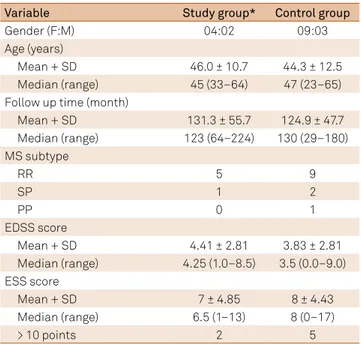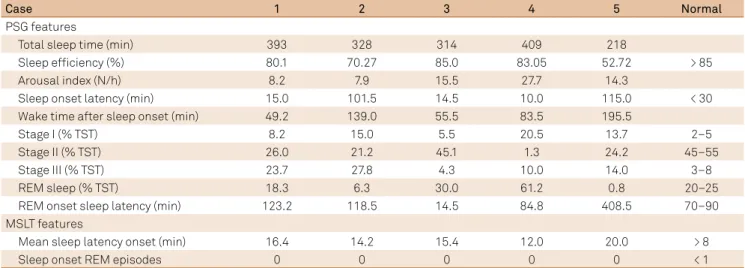345
https://doi.org/10.1590/0004-282X20170063
ARTICLE
Is there a relationship between narcolepsy,
multiple sclerosis and HLA-DQB1*06:02?
Existe relação entre narcolepsia, esclerose múltipla e HLA-DQB1*06:02?
Paulo José Lorenzoni1, Lineu Cesar Werneck1, Ana Christina de Souza Crippa1, Alessandra Zanatta1,
Cláudia S. Kamoi Kay1, Carlos Eduardo S. Silvado1, Rosana Herminia Scola1
he DQB1*06:02 allele of the human leukocyte antigen (HLA) class II is a well-known genetic risk factor for narcolepsy1,2,3.
In addition, the HLA-DQB1*06:02 allele inluences the suscep-tibility and severity of multiple sclerosis (MS)1,2,3. However, few
reports have described the co-occurrence of both disorders and in many of them, the HLA class was not described4,5,6. For that
reason, at the moment, it is diicult to conclude whether this was a coincidental inding, or whether the development of narcolepsy in MS patients was inluenced by their HLA-DQB1 allele status.
he main objective of this study was to investigate the potential relationship be tween the HLA-DQB1*06:02 allele, narcolepsy, and MS.
METHODS
We studied patients who were diagnosed with MS, based on the 2010 McDonald criteria, and divided them into two groups
according HLA-DQB1 status: a study group with HLA-DQB1*06:02 and a control group with other HLA-DQB1 subtypes.
Relevant data, including age, gender, time-period of dis-ease progression (MS follow-up time), MS subtype, Expanded Disability Status Scale (EDSS) score, Epworth Sleepiness Scale (ESS) score, polysomnography (PSG), and the multiple sleep latency test (MSLT) were recorded.
he ESS was performed in both groups to identiied nar-colepsy and scores higher than 10 on the ESS was consid-ered indicative of narcolepsy, according to the International Classiication of Sleep Disorders (ICSD-3)7
.
Polysomnography and the MSLT were performed in the study group, according to standard procedures. he PSG was considered diagnostic of narcolepsy when it indicated short sleep latency, excessive sleep disruption with frequent arousal and increased total sleep time4,7. he MSLT was considerate diagnostic of
nar-colepsy if sleep onset latency was < 8 minutes and two or more sleep-onset REM were present, according to the ICSD-3 criteria4,7.
1Universidade Federal do Paraná, Hospital de Clínicas, Departamento de Medicina Interna, Serviço de Neurologia, Curitiba PR, Brasil.
Correspondence: Rosana Herminia Scola; Serviço de Neurologia do Hospital de Clínicas da UFPR; Rua General Carneiro, 181 / 3° andar; 80060-900 Curitiba PR, Brasil; E-mail: rosana.scola@hc.ufpr.br
Conflict of interest: There is no conlict of interest to declare.
Support: This study was supported by Fundação Araucária, CAPES and CNPq.
Received 16 May 2016; Received in inal form 23 September 2016; Accepted 14 March 2017. ABSTRACT
We studied multiple sclerosis (MS) patients with the HLA-DQB1*06:02 allele and compared them with MS patients who did not carry the HLA-DQB1*06:02 allele. We analyzed clinical and neurophysiological criteria for narcolepsy in six MS patients with HLA-DQB1*06:02, compared with 12 MS patients who were HLA-DQB1*06:02 non-carriers. Only two patients with HLA-DQB1*06:02 allele scored higher than 10 on the Epworth Sleepiness Scale. Polysomnography recording parameters and the multiple sleep latency test showed an absence of narcolepsy in the study group. Our study suggested no signiicant correlation between narcolepsy, MS and HLA-DQB1*06:02. The HLA-DQB1*06:02 allele alone was not suficient to cause MS patients to develop narcolepsy.
Keywords: narcolepsy; multiple sclerosis; human leukocyte antigen; polysomnography.
RESUMO
Pacientes com esclerose múltipla (EM) portadores do alelo HLA-DQB1*06:02 foram estudados e comparados com pacientes com EM mas que não são portadores do alelo HLA-DQB1*06:02. Os critérios clínicos e neuroisiológicos para narcolepsia foram analisados em pacientes com EM sendo 6 pacientes com o HLA-DQB1*06:02 comparados a 12 pacientes sem o HLA-DQB1*06:02. Somente 2 pacientes com EM e HLA-DQB1*06:02 tiveram escore maior que 10 na escala “Epworth Sleepiness Scale”. Os parâmetros da polissonograia e o teste de múltiplas latências do sono mostraram ausência de narcolepsia no grupo estudo. Nosso estudo não sugere correlações signiicantes entre narcolepsia, EM e HLA-DQB1*06:02. Somente o HLA-DQB1*06:02 não foi suiciente para desenvolver narcolepsia em pacientes com EM.
346 Arq Neuropsiquiatr 2017;75(6):345-348
he presence of HLA-DQB1*06:02 was determined by direct sequencing of exons 2 and 3 of the HLA-DQB1 gene [OMIM
604305] using an ABI PRISM 3100 Avant Genetic Analyzer. he data were analyzed using descriptive statistical methods and Fisher’s exact test.
All studies were conducted after patient informed con-sent was obtained.
RESULTS
Twenty-ive of 85 MS patients had at least one copy of the HLA-DQB1*06:02 allele ( ive were homozygous). We included six patients in the study group and excluded the remaining patients because they were unable to attend an appointment to perform PSG or the MSLT, did not give consent or had con-comitant psychiatric disorders. We included 12 MS patients who did not carry the HLA-DQB1*06:02 allele in the control group. Table 1 shows the HLA-DQB1 alleles distribution fre-quencies of both groups.
he sample consisted of 18 patients (13 females and ive males), aged from 23 to 65 years (median 47; mean 44.9 ± 11.6). he time period of disease progression varied between 29 and 224 months with a mean time of 127.05 months. he MS sub-type was relapsing-remitting in 14 patients, secondary progres-sive in three patients and primary progresprogres-sive in one patient. he median EDSS score was 3.5 (0 to 9.0, mean 4.27 ± 2.74). he median ESS score was 8 (0 to 17, mean 7.66 ± 4.45).
he two groups were compared with respect to gender, age, MS follow-up time, MS subtype, EDSS score and ESS score (Table 2).
Only two patients in the study group (HLA-DQB1*06:02) scored higher than 10 on the ESS compared with ive patients in the control group, but this diference did not reach statistical sig-niicance (p = 0.5724). Figure shows the ESS score for both groups.
he PSG recording parameters, performed in ive patients, revealed an absence of narcolepsy criterion in the study group, according to the ICSD-37
. Table 3 shows the range of PSG recording parameters in the study group.
he MSLT was performed in ive patients and showed an absence of narcolepsy criterion in all patients, according to the ICSD-37
. For the MSLT, Table 3 shows normal mean sleep onset latency as well as an absence of sleep-onset REM epi-sodes in all studied patients.
Figure. Epworth Sleepi ness Scale (ESS) scores of patients studied with HLA-DQB1*06:02 (study group) and without HLA-DQB1*06:02 (control group). The line indicates a score of 10 (considered to identify narcolepsy according to the ICSD-3).
Study Group 18 16 12 08 04 0 14 10 06 02 Control Group Table 1. HLA-DQB1 alleles of the multiple sclerosis patients.
Case HLA-DQB1
Allele 1 Allele 2
Study group
1 02:01 06:02
2 04:02 06:02
3 04:02 06:02
4 03:01 06:02
5 06:02 06:02
6 02:01 06:02
Control group
1 02:03 06:08
2 02:01 05:02
3 06:08 06:08
4 05:01 05:03
5 04:02 04:02
6 05:02 06:05
7 03:02 06:01
8 03:02 03:02
9 02:03 03:04
10 03:01 06:03
11 03:02 03:02
12 02:02 03:02
Table 2. Characteristics of the multiple sclerosis patients in the study group (n = 6) and control group (n = 12).
Variable Study group* Control group
Gender (F:M) 04:02 09:03
Age (years)
Mean + SD 46.0 ± 10.7 44.3 ± 12.5
Median (range) 45 (33–64) 47 (23–65)
Follow up time (month)
Mean + SD 131.3 ± 55.7 124.9 ± 47.7
Median (range) 123 (64–224) 130 (29–180)
MS subtype
RR 5 9
SP 1 2
PP 0 1
EDSS score
Mean + SD 4.41 ± 2.81 3.83 ± 2.81
Median (range) 4.25 (1.0–8.5) 3.5 (0.0–9.0)
ESS score
Mean + SD 7 ± 4.85 8 ± 4.43
Median (range) 6.5 (1–13) 8 (0–17)
> 10 points 2 5
347 Lorenzoni PJ et al. Narcolepsy, MS and HLA
DISCUSSION
Some studies have investigated sleep disorders in MS patients, but narcolepsy remains a rare manifestation. To our knowl-edge, approximately 16 patients with concomitant narcolepsy have been reported to date, even though a high number of MS patients present with excessive daytime sleepiness4,8. hus, the
prevalence of narcolepsy is low for MS patients (0 to 1.6%), but only two studies were considered in this estimate8,9.
Currently, there are no speciic guidelines for the inves-tigation of sleep disorders in MS. Clinical and laboratory examination for other causes of sleepiness are generally rec-ommended, and sleep-speciic studies may be required to diagnose possible narcoleptic patients1,7.
Human leukocyte antigen has been described as a predispos-ing factor in the co-occurrence of MS and narcolepsy in a small number of patients4,5,6,10. he HLA-DQB1*06:02 was reported
only in three patients with both disorders5,6,10; HLA-DRB1*15:01
was reported in two patients with concomitance of both disor-ders, but in combination with HLA-DQB1*06:024,5,10. herefore,
in these cases, narcolepsy still seems to have a stronger asso-ciation with HLA-DQB1*06:02 than with HLA-DRB1*15:014,5,10.
Other sporadic HLA alleles were also described as predisposing factors in this association between narcolepsy and MS4
. In the study group, neither short sleep latency nor sleep-onset REM, which are required for the diagnosis of narco-lepsy, occurred during the MSLT. Also in this group, there was no correlation between high ESS scores and the MSLT results. We additionally looked for the presence of REM sleep latency ≤ 14 minutes during nocturnal PSG, which might suggest nar-colepsy, but this abnormality was present in only one of our patients7
. In this way, our indings on PSG and MSLT conirm previous studies that narcolepsy has rarely been found in MS patients, but also suggest that the presence of the DQB1*06:02 allele alone is not suicient to cause narcolepsy in MS patients8.
Our series did not suggest a signiicant relationship between narcolepsy, MS and HLA-DQB1*06:02. herefore, this study showed that narcolepsy in MS patients may yet be coincidental in the presence of HLA-DQB1*06:02, based on the most widely-used scale for narcolepsy (ESS) and neu-rophysiological studies (PSG and MSLT). Although the small number of MS patients with HLA-DQB1*06:02 could inlu-ence our indings, these data suggest that HLA-DQB1*06:02 alone is not suicient for MS patients to develop narcolepsy.
References
1. Alóe F, Alves RC, Araújo JF, Azevedo A, Bacelar A, Bezerra M et al. [Brazilian guidelines for the diagnosis of narcolepsy]. Rev Bras Psiquiatr. 2010;32(3):294-304. Portuguese. http://dx.doi.org/10.1590/S1516-44462010005000014
2. Nishino S, Kanbayashi T. Symptomatic narcolepsy, cataplexy and hypersomnia, and their implications in the hypothalamic hypocretin/orexin system. Sleep Med Rev. 2005;9(4):269-310.
https://doi.org/10.1016/j.smrv.2005.03.004 3. Mahlios J, De la Herrán-Arita AK, Mignot E.
The autoimmune basis of narcolepsy. Curr Opin Neurobiol. 2013;23(5):767-73.
https://doi.org/10.1016/j.conb.2013.04.013
4. Veauthier C. Sleep disorders in multiple sclerosis: review. Curr Neurol Neurosci Rep. 2015;15(5):21. https://doi.org/10.1007/s11910-015-0546-0 5. Vrethem M, Malmgren K, Lindh J. A patient with both
narcolepsy and multiple sclerosis in association with Pandemrix vaccination. J Neurol Sci. 2012;321(1-2):89-91. https://doi.org/10.1016/j.jns.2012.07.025
6. Vetrugno R, Stecchi S, Plazzi G, Lodi R, D’Angelo R, Alessandria M et al. Narcolepsy-like syndrome in multiple sclerosis. Sleep Med. 2009;10(3):389-91. https://doi.org/10.1016/j.sleep.2008.03.009
7. American Academy of Sleep Medicine. International classiication of sleep disorders, 3rd ed: diagnostic and coding manual. Darien: American Academy of Sleep Medicine; 2014.
Table 3. The PSG and MSLT features of the MS patients in the study group (n = 5).
Case 1 2 3 4 5 Normal
PSG features
Total sleep time (min) 393 328 314 409 218
Sleep eficiency (%) 80.1 70.27 85.0 83.05 52.72 > 85
Arousal index (N/h) 8.2 7.9 15.5 27.7 14.3
Sleep onset latency (min) 15.0 101.5 14.5 10.0 115.0 < 30
Wake time after sleep onset (min) 49.2 139.0 55.5 83.5 195.5
Stage I (% TST) 8.2 15.0 5.5 20.5 13.7 2–5
Stage II (% TST) 26.0 21.2 45.1 1.3 24.2 45–55
Stage III (% TST) 23.7 27.8 4.3 10.0 14.0 3–8
REM sleep (% TST) 18.3 6.3 30.0 61.2 0.8 20–25
REM onset sleep latency (min) 123.2 118.5 14.5 84.8 408.5 70–90
MSLT features
Mean sleep latency onset (min) 16.4 14.2 15.4 12.0 20.0 > 8
Sleep onset REM episodes 0 0 0 0 0 < 1
348 Arq Neuropsiquiatr 2017;75(6):345-348
8. Poirier G, Montplaisir J, Dumont M, Duquette P, Décary F, Pleines J et al. Clinical and sleep laboratory study of narcoleptic symptoms in multiple sclerosis. Neurology. 1987;37(4):693-5. https://doi.org/10.1212/WNL.37.4.693
9. Marrie RA, Reider N, Cohen J, Trojano M, Sorensen PS, Cutter G et al. A systematic review of the incidence and prevalence of sleep disorders and seizure disorders
in multiple sclerosis. Mult Scler. 2015;21(3):342-9. https://doi.org/10.1177/1352458514564486

